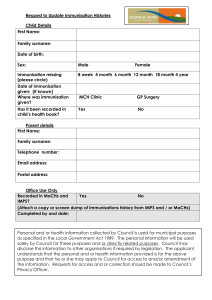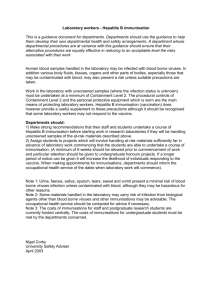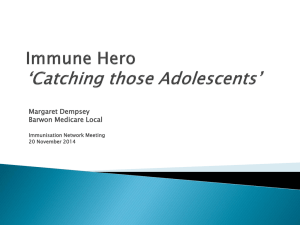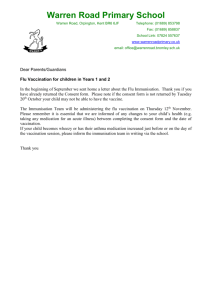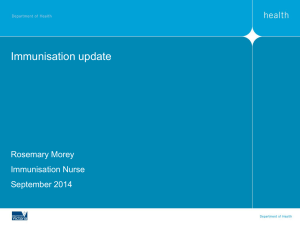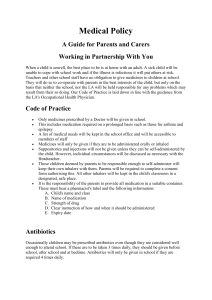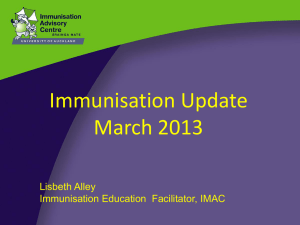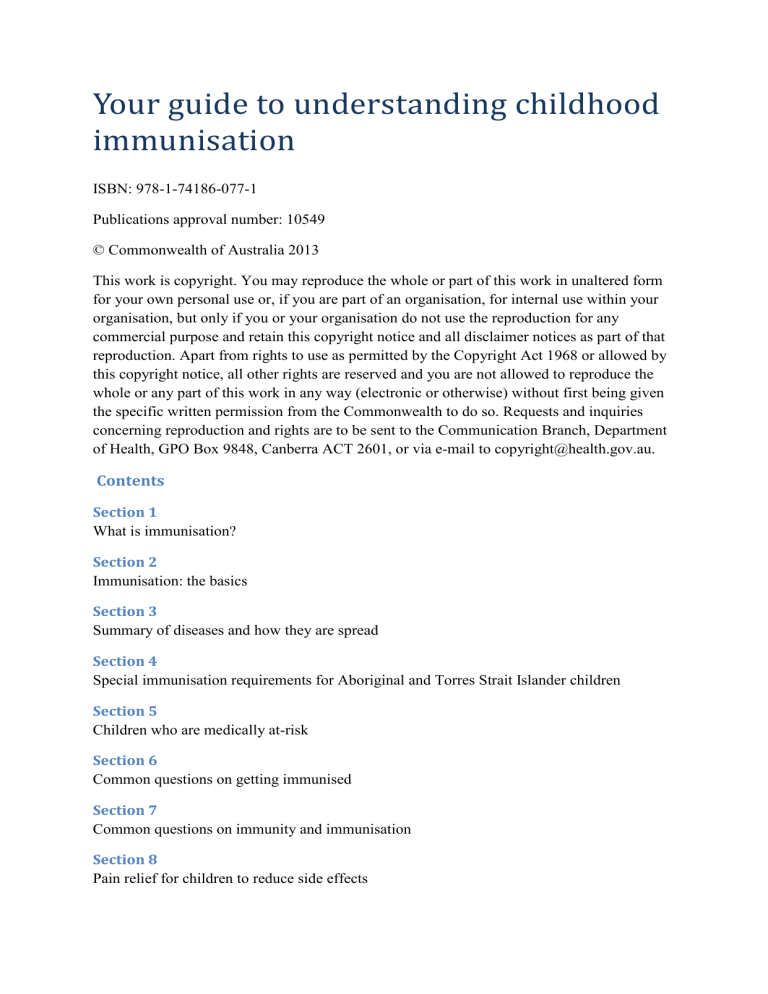
Your guide to understanding childhood
immunisation
ISBN: 978-1-74186-077-1
Publications approval number: 10549
© Commonwealth of Australia 2013
This work is copyright. You may reproduce the whole or part of this work in unaltered form
for your own personal use or, if you are part of an organisation, for internal use within your
organisation, but only if you or your organisation do not use the reproduction for any
commercial purpose and retain this copyright notice and all disclaimer notices as part of that
reproduction. Apart from rights to use as permitted by the Copyright Act 1968 or allowed by
this copyright notice, all other rights are reserved and you are not allowed to reproduce the
whole or any part of this work in any way (electronic or otherwise) without first being given
the specific written permission from the Commonwealth to do so. Requests and inquiries
concerning reproduction and rights are to be sent to the Communication Branch, Department
of Health, GPO Box 9848, Canberra ACT 2601, or via e-mail to copyright@health.gov.au.
Contents
Section 1
What is immunisation?
Section 2
Immunisation: the basics
Section 3
Summary of diseases and how they are spread
Section 4
Special immunisation requirements for Aboriginal and Torres Strait Islander children
Section 5
Children who are medically at-risk
Section 6
Common questions on getting immunised
Section 7
Common questions on immunity and immunisation
Section 8
Pain relief for children to reduce side effects
Section 9
Immunisation and your eligibility for some government benefits
Section 10
Enquiries
Immunisation is a simple, safe and effective way of protecting children against certain
diseases. The risks of these diseases are far greater than the very small risks of immunisation.
It’s estimated that vaccination currently saves approximately three million lives each year
worldwide.
Parents understandably want to do whatever they can to stop their child getting sick. This
guide is a summary of the information in the Understanding Childhood Immunisation
booklet, and will help you make an informed decision on immunisation based on the most
accurate information available.
To view the full Understanding Childhood Immunisation booklet visit the Immunise
Australia Program website at immunise.health.gov.au
If you have any questions about the information in this guide, please discuss with your
General Practitioner or immunisation provider.
Fact
Over 90% of children are vaccinated in Australia.
Section 1
What is immunisation?
Immunisation protects people against harmful infections before they come into contact with
them. Immunisation uses the body’s natural defences to build resistance to specific infections
and helps children (and adults) stay healthy by preventing serious infections.
This guide focuses on the vaccines for young children funded under the National
Immunisation Program.
The routine childhood immunisations given through this program currently provide
protection against 13 diseases:
• diphtheria;
• haemophilus influenzae type b (Hib);
• hepatitis B;
• measles;
• meningococcal C;
• mumps;
• whooping cough (pertussis);
• pneumococcal disease;
• polio (poliomyelitis);
• rotaviral gastroenteritis;
• rubella (German measles);
• tetanus; and
• chickenpox (varicella).
Most of these diseases can cause serious complications and sometimes death.
It is also recommended that children at risk receive the seasonal influenza vaccination.
Immunisation and vaccination - what’s the difference?
‘Vaccination’ is the term used for giving a vaccine - actually getting an injection or oral dose.
‘Immunisation’ is the term used for the process of both getting the vaccine and becoming
immune to the disease as a result.
Why should I have my child immunised?
Immunisation is the safest and most effective way of giving protection against a disease.
After immunisation, your child is far less likely to catch the disease if there are cases in the
community. If your child does catch the disease, illness is less severe and recovery is quicker
compared to an unimmunised child.
If enough people in the community are immunised, the infection can no longer be spread
from person to person and the disease might die out altogether. This is how smallpox was
eliminated from the world, and how polio has disappeared from many countries.
Fact
All vaccines available in Australia have been thoroughly tested for safety and efficacy and
receive ongoing monitoring and evaluation.
Section 2
Immunisation – the basics
How does immunisation work?
When a person gets a vaccine, their body produces an immune response in the same way it
would after exposure to a disease, but without suffering symptoms. When someone comes in
contact with that disease in the future, their immune system remembers it and responds
quickly, preventing the disease from developing.
Why do children need so many vaccinations?
A number of vaccinations are required in the first few years of life because the immune
system in young children does not work as well as in older children and adults – it is still
maturing, meaning exposure to diseases such as whooping cough can have life- threatening
consequences.
The number of injections is reduced by the use of combination vaccines, where several
vaccines are combined into one injection.
What is in vaccines?
Vaccines can contain a very small dose of a live (but weakened) virus, killed viruses, killed
bacteria (or small parts of bacteria), or a small dose of a modified toxin produced by bacteria.
Vaccines may also contain either a small amount of preservative or a small amount of an
antibiotic to preserve the vaccine.
Some vaccines, such as influenza, may contain traces of egg protein and should be given with
caution to people with a known egg allergy.
What are the side effects of immunisation?
Common side effects of immunisation are redness and soreness where the child has been
injected, and mild fever. You may consider using pain relief to help ease any fever or
soreness. More serious reactions to immunisation are very rare, but if they do occur, a doctor
should be consulted immediately.
How long do immunisations take to work?
The normal immune response takes approximately two weeks to work. Most vaccines need to
be given more than once to build long lasting protection.
How long do immunisations last?
It varies. Some, like tetanus vaccine, can last up to 30 years, after which time a booster dose
may be given. Some, such as whooping cough, give protection for about five years after a full
course. Seasonal influenza vaccinations need to be given every year.
Are all immunisations free?
Vaccines that are routinely recommended for your child under the National Immunisation
Program are funded by the Australian Government and are free if your child is eligible for
Medicare. Your doctor may charge you for a consultation fee.
Some additional vaccines are provided free of charge for children with specific medical
conditions and Aboriginal and Torres Strait Islander children in the Northern Territory,
Western Australia, South Australia and Queensland. See the full Understanding Childhood
Immunisation booklet on the Immunise Australia website at immunise.health.gov.au for more
information.
There are some differences in the way government funded immunisation programs are
administered in each state and territory. If you are unsure which vaccines are free, speak to
your GP or immunisation provider, refer to the National Immunisation Program Schedule
magnet attached to this guide, or telephone the Immunise Australia Information Line on 1800
671 811.
Section 3
Summary of diseases and how they are spread
The following is a summary of the diseases the National Immunisation Program routine
childhood immunisations currently provide protection against, and how they are spread.
For more detailed information please refer to the full Understanding Childhood Immunisation
booklet at immunise.health.gov.au
Chickenpox
Caused by highly contagious virus; causes low grade fever and vesicular rash. Spread by
respiratory secretions or fluid from open rash blisters.
Signs and Symptoms:
Rash, fever, difficulty walking and balancing
Complications:
Infection of lesions, pneumonia, brain infection, meningitis
(inflammation of the membranes around the brain and spinal cord)
Diphtheria
Contagious bacteria spread by droplets; causes severe breathing difficulties.
Signs and Symptoms:
Complications :
difficulties
Sore throat, mild fever, swollen neck
Nerve and heart damage, membrane in throat causing breathing
Hib Disease
Contagious bacteria spread by respiratory droplets; causes meningitis, epiglottitis (respiratory
obstruction), septicaemia, osteomyelitis (infection of the bones).
Signs and Symptoms:
high fever
Complications:
Neck stiffness, sensitivity to lights, drowsiness, loss of appetite,
Meningitis, arthritis, pneumonia, death
Hepatitis A
Contagious virus spread by contact with faeces or saliva, contaminated food or water.
Signs and Symptoms:
Fever, weakness, loss of appetite, vomiting, dark urine, pale
faeces, jaundice, stomach pain
Complications:
Liver infection and damage
Hepatitis B
Contagious virus spread mainly by blood, sexual contact or from mother to newborn baby.
Causes acute hepatitis or chronic carriage.
Signs and Symptoms:
Weakness, loss of appetite, headache, vomiting, stomach pain,
muscle/joint pain, dark urine, pale faeces, jaundice
Complications:
Liver failure, liver cancer
Influenza
Contagious virus spread by respiratory droplets, causes tiredness, high fever, chills, headache,
cough, sneezing, running nose, poor appetite and muscle aches.
Signs and Symptoms:
sneezing, runny nose
Complications :
Tiredness, fever, chills, loss of appetite, muscle aches, cough,
Pneumonia, liver complications, death
Measles
Highly infectious virus spread by respiratory droplets; causes fever, cough and rash.
Signs and Symptoms:
Complications:
Rash, fever, cough, runny nose, eye inflammation
Ear, brain and lung infection, brain damage, death
Meningococcal C Disease
Bacteria spread by respiratory droplets; causes sepsis (infection of the blood stream) and
meningitis (infection of the tissues surrounding the brain).
Signs and Symptoms:
irritability, drowsiness
Complications:
High fever, neck stiffness, vomiting, sensitivity to light,
Meningitis, blood infection, pneumonia, arthritis, conjunctivitis
Mumps
Contagious virus spread by saliva; causes swollen neck glands, fever.
Signs and Symptoms:
Swelling under the jaw area, fever, headache, aching muscles
Complications:
Infection of testicles, ovaries, pancreas, liver, brain and heart, hearing
loss, brain inflammation, sterility in men
Polio
Contagious virus spread by faeces and saliva; causes fever, headache, vomiting and may
progress to paralysis.
Signs and Symptoms:
90% of the time there are no symptoms but they can include
vomiting, tiredness, muscle pain, paralysis
Complications:
Meningitis, paralysis, death
Pneumococcal Disease
Bacteria spread by respiratory droplets; causes fever, pneumonia, septicaemia and meningitis.
Signs and Symptoms:
High fever, headache, vomiting, sensitivity to light, neck
stiffness, loss of appetite, irritability, drowsiness
Complications:
Meningitis, pneumonia, blood infection, middle ear, sinus infection
Rotavirus
Contagious virus spread by faeces and saliva; causes severe gastroenteritis and fever.
Signs and Symptoms:
Complications :
Diarrhoea, vomiting, fever
Severe diarrhoea, dehydration or shock
Rubella
Contagious virus spread by respiratory droplets; causes rash, fever and swollen glands and
may cause severe malformations to babies of infected pregnant women.
Signs and Symptoms:
Complications :
Rash, swollen lymph glands, joint pain
Brain infection
Tetanus
Toxin-producing bacteria in soil that can spread to humans through cuts in the skin.
Signs and Symptoms:
rhythms
Complications :
Muscle spasms, lockjaw, breathing difficulties, abnormal heart
Breathing difficulties
Whooping Cough
Contagious bacteria spread by respiratory droplets. Causes persistent coughing for up to three
months, occasionally associated with vomiting.
Signs and Symptoms:
Complications:
Coughing, runny nose, fever
Lung infection, lack of oxygen to the brain, brain damage, death
Section 4
Special immunisation requirements for Aboriginal and Torres Strait Islander
children
Aboriginal and Torres Strait Islander children living in Queensland, the Northern Territory,
Western Australia and South Australia should receive all the routine vaccines given to other
children with some additions.
For further information, contact your immunisation provider or your state or territory health
department using the numbers included in the contacts section of this booklet.
Section 5
Children who are medically at risk
If your child has a chronic disease, allergies or asthma, has had a fit or has epilepsy, please
see the full Understanding Childhood Immunisation booklet on the Immunise Australia
website at immunise.health.gov.au or speak to your GP or immunisation provider.
Fact
Immunisation protects against harmful infections before your child comes into contact with
them.
Section 6
Common questions on getting immunised
Where can my child get immunised?
Immunisations can be provided at immunisation clinics, general practices, some hospitals,
local councils and Aboriginal Community Controlled Health Services.
Are immunisations compulsory?
No, but they are highly recommended for all children. Some states and territories require a
record of a child’s immunisation status to be presented when the child attends day care or
starts school. This is so the day care centre or school knows which children are not
immunised if there is an outbreak.
Does my child have to start the schedule again if they miss a vaccination?
To get full protection, a child needs to have all the recommended vaccine doses, preferably
on time.
For most vaccines, if your child has fallen behind it is easy to catch up. There is no need to
repeat the doses already received and there is no need to get extra doses. Talk to your GP or
immunisation provider for more information.
Can more than one immunisation be given at the same time?
Yes. The vaccines recommended for routine use in babies and children can safely be
administered at a single visit. There is a need to wait four weeks between giving live
vaccines, if they are not given on the same day.
What if my baby was born premature?
Premature babies need the protection of immunisation because they are more prone to certain
infections.
In general, babies born prematurely receive the same immunisations as other babies.
However, very low birth weight babies may have a lower response to hepatitis B and may
need an extra dose of the vaccine. Also, premature babies born at less than 28 weeks require
an extra dose of pneumococcal vaccine at 12 months of age. The immunisation requirements
of a very low birth weight baby should be discussed with your doctor.
If my child has a cough or cold, should immunisations be delayed?
Babies with minor coughs and colds without fever, or those receiving antibiotics in the
recovery phase of an acute illness, can be immunised safely and effectively. Ask your GP or
health clinic staff before delaying immunisation.
Should children be immunised while their mother is pregnant?
There is no problem with giving routine immunisations to a child whose mother is pregnant.
What if someone else in the family has had a reaction to an immunisation?
Immunisations should not be missed if another family member has had any reaction to a
vaccine as these reactions are not hereditary.
What if my child has a reaction after receiving a vaccination?
Reporting adverse events following immunisation is important.
You should report an adverse event to your immunisation provider. Alternatively, advise the
Therapeutic Goods Administration at tga.gov.au/safety/index.htm
What if my child is due to have an operation?
Immunisations should not be postponed if a child is due to have an operation.
Are there any reasons for delaying immunisation?
If a child is sick with a high temperature (over 38.5 degrees Celsius), immunisation should be
postponed until the child is recovering. In some instances, children with cancer, an immune
deficiency disorder or who are on medications which may interfere with their ability to fight
infection, should not be immunised with vaccines that contain live viruses such as Measles,
Mumps and Rubella (MMR) and chickenpox vaccines. Children who have had a blood
transfusion or immunoglobulin should not have their MMR or chickenpox vaccine until up to
six months after the transfusion. If you are in doubt about whether your child is fit for
immunisation, discuss the circumstances with your doctor or nurse before postponing
immunisation.
How can I keep track of my child’s immunisations?
The Australian Childhood Immunisation Register (ACIR or Immunisation Register) records
information about immunisations given to Australian children.
You can request a statement at any time by visiting Medicare Online Services at the
Immunisation Register website (humanservices.gov.au).
Section 7
Common questions on immunity and immunisation
Are immunisations still necessary?
Yes. Many diseases prevented by immunisation are spread directly from person to person, so
good food, water and hygiene do not stop infection.
Can immunisations overload the immune system?
No. Children and adults come into contact with many antigens (substances that provoke a
reaction from the immune system) each day, and the immune system responds to each in
various ways to protect the body. While the risks associated with the diseases are high, the
risks associated with vaccination are low.
Do some children get the disease despite being immunised?
A small proportion of those who are immunised will remain susceptible to the disease.
However, when illness does occur in immunised children, it is usually much less severe.
Should breastfed children still get immunisations?
Breastfed children should be immunised. Breast milk does not provide permanent protection.
Do vaccines cause cancer, chronic fatigue syndrome, multiple sclerosis, allergies, or
auto-immune disease?
No. After millions of vaccinations over many decades, there is no evidence to suggest that
immunisations cause such diseases and conditions.
Does MMR vaccine cause inflammatory bowel disease or autism?
There is no validated scientific evidence to support this suggestion.
Fact
The risk from childhood disease is much higher than the risks of immunisation.
Section 8
Pain relief for children to reduce side effects
To reduce fever or discomfort after vaccination, you can use pain or fever relief medicines,
such as paracetamol, as directed.
Section 9
Immunisation and your eligibility for some government benefits
A number of government family assistance payments require children to meet the
immunisation requirements.
For more information, visit humanservices.gov.au/ immunisation or visit a Centrelink or
Medicare Service Centre.
Fact
Skipping vaccinations puts your child at greater risk of contracting vaccine preventable
diseases.
Section 10
Enquiries
Australian Capital Territory
ACT Immunisation Inquiry Line (02) 6205 2300
New South Wales
1300 066 055
Northern Territory
(08) 8922 8044
Queensland
Contact the local Public Health Units (look under “Health” in the White Pages) or 13
HEALTH (13 43 25 84) 24 hour health hotline
South Australia
Immunisation Section 1300 232 272
Tasmania
1800 671 738
Victoria
1300 882 008
Western Australia
(08) 9321 1312
The Australian Childhood Immunisation Register
1800 653 809 (free call – Interpreter service to translate records also available).
To order additional copies of this guide, visit immunise.health.gov.au or call the Immunise
Australia Information line on 1800 671 811.
To view the full Understanding Childhood Immunisation booklet visit the Immunise
Australia Program website at immunise.health.gov.au
A joint Australian, State and Territory Government initiative
All information in this publication is correct as at December 2013

